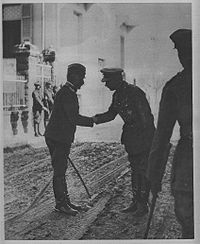Zivojin Misic - Picture
More about World War 1

|
|
Zivojin Misic
Place of birth: Mionica, Serbia
Place of death: Belgrade, Kingdom of Serbs, Croats and Slovenes
Allegiance: Principality of Serbia
Kingdom of Serbia
Years of service: 1874 - 1918
Rank: Field Marshal
Battles/wars: Serbo-Turkish wars, Serbo-Bulgarian War, First Balkan War, Second Balkan War, World War I
Awards: Order of the Star of Karageorge
Knight Grand Cross of The Most Distinguished Order of Saint Michael and Saint George
Order of the Star of Karageorge

Picture - General Misic and British general George Milne.
Zivojin Misic (1855 - January 20, 1921) was a Vojvoda (Field Marshal) and the most successful Serbian commander who participated in all Serbia's wars from 1876 to 1918.
Early years
Misic's grandfather was born in Struganik near Mionica. His parents Radovan and AnÄ‘elija (born Damjanović - Koštunjić) had thirteen children, of which only two were girls - Todora and Živana.
Zivojin was the youngest child, and when he was born, only eight of his brothers and sisters were still alive. When he turned 6 years, he became a shepherd. He finished primary school in Kragujevac. In his memories, he mentions troubles he had with the city kids that teased him because of his peasant origin. In 1868, he started his gymnasium education in Kragujevac, where he finished 1st, 2nd, and 6th grade. He finished third and fourth grade in Belgrade. In the first five gymnasium grades he was not a particularly good student, but he finished 6th grade with much greater success. Because of that, he was admitted to the Military Academy in 1874, ranked 19th. On every holiday he visited his village, and often he worked on field with his brothers.
He participated with distinction in Serbo-Turkish wars of 1876. and 1878. with the rank of lieutenant JG of infantry and in Serbo-Bulgarian War of 1885. as full lieutenant - a company commander in the 5th infantry regiment of Drinska division.
Sometime after the assassination of king Aleksandar Obrenović he was forced to retire, supposedly through the influence of "Black Hand" as he was considered too close to the Obrenović dynasty, but was reactivated on personal insistence of the Chief of staff of High command of the Serbian army, General Radomir Putnik who made him his aide.
Military career
After the battle of Kumanovo of the First Balkan War, he was promoted to General. During the critical moments of Bulgarian surprise offensive at the Battle of Bregalnica of the Second Balkan War, when most of the staff suggested that the Serbian Army should withdraw to the second line of defence, Mišić (still Aide of Chief of Staff) strongly disagreed and persuaded Vojvoda Putnik to order the Army to repel the attack on the first line, thus contributing greatly to the Serbian victory at the battle. Prior to World War I, along with General Stepa Stepanović, he planned movements of the Serbian army, which eventually won a victory at the mountain of Cer. At the height of Battle of Kolubara Mišić was handed command over the Serbian First Army, then in very difficult situation, to replace its wounded and sick commander General Petar Bojović. Largely through his personal effort and knowledge was that unit made battle-worthy again. He insisted on (then considered risky) deeper withdrawal of the whole Serbian army to gain time for some rest and improve supplies, which resulted in the abandonment of Belgrade. He made the kind of, in American football terminology, "shotgun" formation. By shortened supply lines and most of his soldiers in dry and hot places (cold weather already started) for 3 days he refreshed his army and prepared it for offensive. His gamble, however, paid off as Austro-Hungarian army overstretched its supply routes and was soundly beaten in the subsequent Serbian counteroffensive, which Mišić also initiated, and his army playing the decisive role. That was one of the greatest battles in the Serbian history and he was promoted to the rank of Vojvoda. As the Serbian Army settled in Kosovo, in 1915, Mišić was eager to perform counteroffensive actions. This was denied by other army commanders at their meetings at Peć, and the withdrawal of Serbian forces over Montenegro and Albania followed. At the Thessaloniki Front in 1916, he led the First Serbian Army, and was made Chief of staff of High command towards the end of the war, directing the Serbian Army operations in the breakthrough of Thessaloniki front in September 1918.
Death
He died on January 20, 1921 in Belgrade.
Decorations
Order of the White Eagle (Serbia), II class;
Order of the White Eagle (Serbia) with swords, IV class;
Order of the Cross of Takovo, II class;
Order of the Cross of Takovo, III class;
Order of the Karađorđe's Star, I class;
Order of the Karađorđe's Star with Swords, II class;
Order of the Karađorđe's Star with Swords, III class;
Order of the Karađorđe's Star with Swords, IV class;
Medal of the Serbian Red Cross;
Order of Prince Danilo I, II class;
Legion of Honour, I class;
Legion of Honour, II class;
Croix de guerre 1914-1918 (France);
Order of the Bath;
Order of St Michael and St George, I class;
The Balkan war medal of the British Red Cross;
Order of the Redeemer, I class;
Medal for Highly Meritorius Service of the American Red Cross;
Distinguished Service Medal (Army);
Order of the Crown, II class;
Order of Saint Stanislaus, II class;
Order of St. George, IV class;
Order of the Medjidie, II class;
Order of the Crown of Italy, I class;
Croce di Guerra.
Sources
This article is originally based on a text which has been published on freesrpska.org. Note that some of the contents of the site might be propagandistic, wrong and/or biased.
Savo Skoko, "Vojvoda Stepa Stepanović", Belgrade 1985.
More aircraft.
Source: WikiPedia